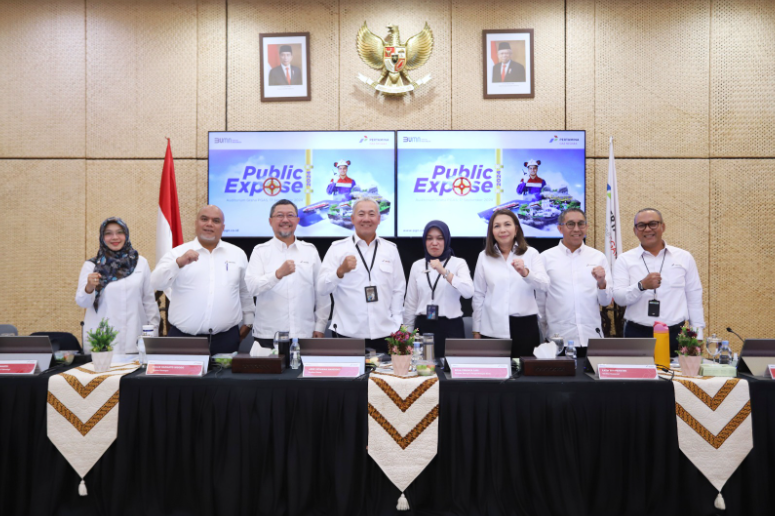Kembali Ke Beranda
17 Sep 2024
PGN's Growth Initiatives and National Gas Infrastructure Integration Maintain Strong Performance in H1 2024
Jakarta, September 17, 2024
PT Perusahaan Gas Negara Tbk (PGN), a gas subholding of PT Pertamina (Persero), continues to implement initiatives to expand the utilization of natural gas across various customer segments in Indonesia. Over the past four years, consolidated revenues have shown an upward trend, growing by 8% from 2020 to 2023, supported by the volume of gas trade and transportation, which contribute around 70% of the company’s revenue.
In line with revenue growth, since 2021, PGN has been able to manage and maintain consolidated profitability, which is crucial to support the company's ability to invest and grow sustainably.
Throughout the first half of 2024, the majority of the natural gas volume, accounting for 99.6%, came from pipeline gas, which remains the main driver of PGN's performance. Meanwhile, LNG regasification commercialization accounted for 0.4%. Of the gas supply, 38% came from the Pertamina Group, and the remainder came from other gas suppliers, including the Corridor Block.
PGN’s revenue for the first half of 2024 reached USD 1.839 billion, up 3% compared to the same period last year (Year on Year/YoY). At the same time, the cost of revenue increased by only 1%, amounting to USD 1.432 billion in H1 2024 compared to USD 1.415 billion in H1 2023, resulting in a gross profit increase of 11%, reaching USD 407 million from USD 368 million YoY.
"Overall, the company has shown sustainable growth and increasing profitability. We believe that by continuing to implement our business strategy, optimizing operational management, and applying prudent financial and risk management, the company will be able to face challenges and seize opportunities," said PGN's President Director, Arief Setiawan Handoko.
Operating income also increased by 3%, reaching USD 293 million compared to USD 284 million YoY. On the bottom line, PGN’s net income grew 28%, reaching USD 187 million in H1 2024 compared to USD 145 million in H1 2023. During the first half of 2024, EBITDA remained stable at USD 578 million, which was contributed by a reduction in foreign exchange gains and depreciation costs. EBITDA was contributed 75% by the gas trade, transmission, and other segments, with 25% coming from upstream.
The gas trade and transmission business contributed 73% of the company's total revenue, with 11% from upstream and the remaining 16% from other business lines. Adopting a cautious approach in investment planning amid the dynamics of the national and global economy, the company’s capital expenditure for the first half of 2024 reached USD 70 million, with 44% allocated to downstream and other segments, while 56% was absorbed by the upstream segment.
Currently and in the future, pipeline infrastructure, alongside beyond-pipeline gas infrastructure, will become PGN’s main scheme for optimizing the use of natural gas. From an operational perspective, the gas trade segment has been affected by the imbalance between supply and demand. There has been a decrease in pipeline gas supply due to natural decline from suppliers in Sumatra and Java, as well as the Lebaran holiday in Q2 2024. This supply challenge needs to be mitigated by increasing LNG supply.
“The company continues to implement a well-measured strategy in line with the government’s plan to optimize the use of natural gas as a transition energy source. To this end, the company has undertaken several initiatives, including building and expanding integrated gas infrastructure to encourage the growth of user segments,” said Arief.
Arief added that these initiatives would drive the long-term sustainability and reliability of the company’s core business. At the same time, PGN continues to prioritize innovation and solutions to meet customer needs, including introducing LNG in response to declining natural gas supply from existing wells.
The company's infrastructure development plan for 2025-2027 has been prepared to ensure business growth, especially amidst the challenging situation, leveraging the momentum of economic recovery, energy transition acceleration, and the need to develop downstream business segments that support carbon emission reductions (low-carbon business).
The increased use of LNG is reflected in the achievement of LNG regasification through the Terminal Use Agreement (TUA) for the FSRU Lampung. As customer demand is met and FSRU Lampung is optimized, the volume of gas distribution reached 65 BBTUD, an increase of 76% compared to the January-June 2023 period.
“PGN will continue to develop its core business, including the transmission and distribution of natural gas projects. At the same time, PGN will remain adaptive and grow through new initiatives, such as expanding the LNG business, focusing on logistics cost efficiency and effectiveness in gas distribution,” he added.
PGN is also ready to collaborate with the government to complete the Cirebon-Semarang gas pipeline project, stage II. This pipeline will transport natural gas from East Java to West Java. There are new business initiatives aligned with the development of the Cisem II pipeline, where PGN will build a Distribution Pipeline from Tegal to Cilacap for the gasification of the Cilacap Refinery Unit IV. PGN is collaborating with PT Kilang Pertamina Internasional (KPI) for this project, which is scheduled to begin in 2025, with a commissioning volume of around 51 MMSCFD.
PGN will also be involved in the strategic WNTS-Pemping gas pipeline project to transport gas from the Natuna Field to the domestic market. The Dumai-Sei Mangkei pipeline construction plan by the government, funded through the state budget, has the potential to integrate gas pipelines in Sumatra, providing PGN with an opportunity to secure gas supply from the Andaman Block. The Arun LNG facility is also expected to be utilized to supply gas from the Andaman Block.
The increased use of natural gas can be realized from infrastructure integration in Central Java, which has been implemented through the Onshore Receiving Facility (ORF) operated by PGN’s gas subholding affiliate, PT Pertamina Gas (Pertagas). This facility distributes gas from the PEP Jambaran Tiung Biru (JTB) field through the Gresik-Semarang pipeline. The infrastructure from JTB, with pressure and distribution handled at the Tambak Rejo ORF, integrates with the completion of the Central Java distribution system, delivering gas to the Tambak Lorok power plant and several industries, commercial sectors, and households in Semarang-Demak.
This infrastructure integration strengthens the services of the Cirebon-Semarang pipeline Stage I (Cisem I), which serves gas needs in the Kendal Special Economic Zone (KEK), Tambak Aji Industrial Area, Wijaya Kusuma Industrial Area, Tambak Lorok IP, as well as households and industries in Semarang-Demak. The infrastructure integration has increased the gas absorption in Central Java from 48 BBTUD to 60-70 BBTUD.
The addition and integration of this infrastructure are expected to better meet the gas needs of both industrial and household customers. In Central Java, the optimization of gas infrastructure is expected to fulfill the gas needs for power plants, 31 industries and commercial businesses, as well as 29 small customers. Gas absorption has increased from 0.5 BBTUD to 3.5 BBTUD.
“PGN is undertaking these initiatives with a clear mission and commitment to consistently provide gas-based energy that adds value to all of our customers,” he emphasized.
Furthermore, the revitalization of the Arun LNG tank continues to progress toward the goal of making the Arun LNG Terminal a leader in LNG hubs in Asia. One of the initial stages is the revitalization of the F-6004 tank. By Q2 2024, the construction progress of non-tank packages reached 27.227%, while tank packages reached 8.16%.
In addition to the strategy to optimize the absorption of natural gas as transition energy, the expansion of transmission and distribution will also drive PGN’s long-term profitability. This aligns with the increasing demand from customers as the national economy continues to grow.
As of the first half of 2024, PGN’s pipeline network spans 13,319 km, an increase of 626 km. The total number of PGN customers reached 821,245, comprising 3,165 industrial and commercial customers, 2,017 small customers, and 816,063 households.
Apart from gas transmission infrastructure, PGN will also build infrastructure for transporting other forms of energy via pipelines, such as the construction of a fuel oil pipeline. This effort is being carried out through synergy between its subsidiary PT Pertamina Gas (Pertagas) and PT Pertamina Patra Niaga (PPN) to build the Cikampek – Plumpang fuel pipeline using the Build Maintenance-Transfer (BMT) scheme with a 10-year operational period.
“The development of this pipeline is part of the Subholding Gas’s business portfolio expansion, especially in the energy transport infrastructure sector. We are currently preparing the Pipeline Service Agreement for the Cikampek – Plumpang fuel pipeline between Pertagas and PPN. This infrastructure will have a capacity of 4.6 billion liters per year with a length of 96 km,” he concluded. (*).
Kembali Ke Beranda











